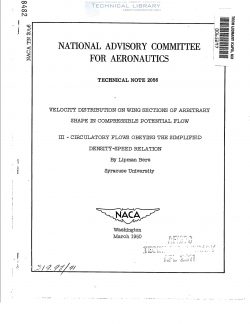naca-tn-2056
- Version
- 135 Downloads
- 1.38 MB File Size
- 1 File Count
- December 9, 2016 Create Date
- December 9, 2016 Last Updated
National Advisory Committee for Aeronautics, Technical Notes - Velocity Distribution on Wing Sections of Arbitrary Shape in Compressible Potential Flow - III - Circulatory Flows Obeying the Simplified Density Speed Relation

The method of computing velocity and pressure distributions along
wing profiles under. the assunmtion of the simplified density—speed
relation, outlined in NACA Technical Note 1006, is extended to the case
of a nonsymnetrical profile and a flow with circulation. The shape of
the profile, ,the speed of the undisturbed flow, and a parameter deter—
mining the angle of attack may be prescribed. The problem is reduced
to a nonlinear integral equation which can be solved numerically by an
iteration method. A numerical example is given.
This paper treats the flow of a comressible fluid past a wing
section under the assumption of Chaplygin's simplified density—speed
relation (references 1, 2, and 3). The method is sufficiently well
known to preclude the necessity of a detailed discussion. It will
suffice to recall that it consists of replacing the "exact" density—
speed relation in a potential flow.
For flows past airfoils obeying the simplified density—speed
relation, the "inverse problem" (construction of a flow past a profile
without predetermining the shape of the profile) was solved by Tsien
(reference 1+) for flows without circulation. A formula generating
circulatory flows was given by the author (reference 5) and, in a more
elegant and general form, by Gelbart (reference 6). The latter result
was also obtained independently by Lin (reference 7). In a. recent
report (reference 8) the "direct problem" (construction of a flow past
a given profile) was solved for the case of a circulation—free flow and
a symmetrical profile. The solution for the general case is given in
this report. It will be seen that the corresponding boundary—value
problem is equivalent to a mapping problem, similar to the conformal
mapping problem occurring in the theory of incompressible fluid. This
mapping problem may be reduced to an integral equation somewhat similar
to the well—known equation of Theodorsen and Garrick but not identical
with it even in the case of infinitely slow (and therefore incompress—
ible) flows. The integral equation can be solved numerically by an
iteration method which seems to converge, though a rigorous convergence
proof is still lacking.
| File | Action |
|---|---|
| naca-tn-2056 Velocity Distribution on Wing Sections of Arbitrary Shape in Compressible Potential Flow - III -.pdf | Download |

Comment On This Post